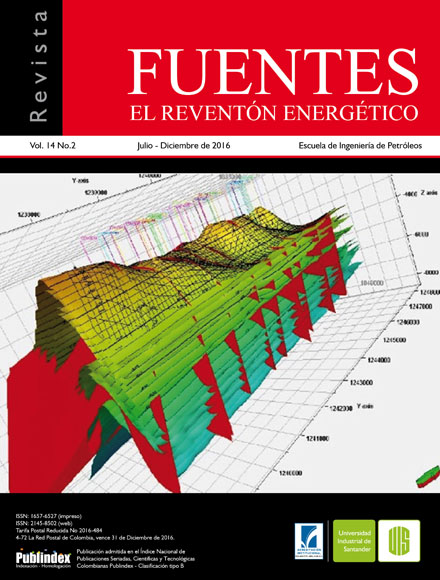Effects of dopant products on fluids for core flooding tests using computed tomography
Published 2017-01-30
Keywords
- Dopants,
- Computerized tomography,
- Viscosity
How to Cite
Copyright (c) 2016 Fuentes, el reventón energético

This work is licensed under a Creative Commons Attribution 4.0 International License.
Abstract
Colombia is innovating in the use of computerized tomography for the study of enhanced oil recovery methods that could be applied on mature fields, i.e., those that have reached the maximum production and have entered in a declining stage. The computerized tomography has proven advantageous in the medical field and among others. The technique is based in the use of X rays to obtain digitally reconstructed cross sections from fluids, objects or materials.
The fluids visualization can be improved using contrast products, also known as dopants. In the petroleum industry, those products are used in displacement tests with the purpose of generating a remarkable contrast for the injected fluids in the rock. Its use has been poorly documented, whereby, the present research has the objective of developing an initial study on the effect that dopants will have in images visualization and fluids viscosity. For this purpose, a bibliographical review about the effect on images resulting from these processes was carried out. Moreover, an experimental design was elaborated to evaluate the effect of those products on viscosity for two petroleum and a brine sample. The above, aiming to establish conceptual and experimental bases that contribute to the learning curve about the use of this technique in the petroleum engineering.
Downloads
References
- Cuñado , C. E., 2012. Estudio geoquímico de los
- petróleos de los campos Jilguero y Caracara,
- Cuenca de los Llanos, Colombia. Barcelona:
- Universidad Politecnica de Catalunya.
- Dake, L. P., 2005. Fundamentals of Reservoir
- Engineering. San Diego,USA: Elsevier.
- Evans, 1955. The Atomic Nucleus. New York City:
- McGraw-Hill Book Co.
- Gonçalves Machado, C., 2013. Histerese nas curvas
- de permeabilidade relativa trifásica em carbonatos
- usando tomografia computadorizada de raios-X.
- UNICAMP.
- Hounsfield, G. N., 1973. Computerized transverse
- axial scanning (Tomography). Part I. Description of
- system.. Br. J. Radiol, Volumen 46, pp. 1016-1022.
- Hove, A. O., Ringen, J. K. & Read, P. A., 1987.
- Visualisation of laboratory corefloods with the aid
- of computerized tomography of X-rays.. SPE, pp.
- -154.
- Hunt , P. K. & Engler, P., 1987. Computed
- tomography as a core analysis tool: applications and
- artefact reduction techniques. SPE, pp. 197-204.
- Ledley, R. S., Di Chiro, G., Luessenhop, A. J. &
- Twigg, H. L., 1974. Computerized transaxial X-ray
- tomography of the human body.. Science, Volumen
- , pp. 207-212.
- Mackay, R. S., 1984. Medical images and displays.
- Wiley, New York.
- Payne, J. T. & McCullough, E. C., 1976. Basic
- principles of computer-assisted tomography.. Appl.
- Radiol, pp. 53-60.
- Peters, E. J. & Hardham, W. D., 1990. Visualization of
- fluid displacements in porous media using computed
- tomography imaging. Journal of petroleum Science
- and Engineering, Volumen 4, pp. 155-168.
- Sheng, J. J., 2013. Enhanced Oil Recovery Field
- Case Studies. Oxford,UK: Elservier.
- Siddiqui, S., Hicks, P. J. & Grader, A. S., 1996.
- Verification of Buckley-Leverett three-phase
- theory using computerized tomography. Journal of
- petroleum Science and Engineering, Volumen 15,
- pp. 1-21.
- Storm, E. & Israel, H. I., 1970. Nuclear Data, Tables
- A7,Photon Cross Sections From 1 Kev to 100 Mev
- for elements Z=1 to Z=100.. California: University
- of California.
